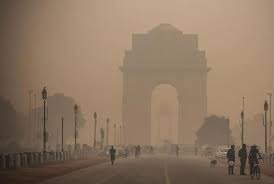Delhi’s air quality is classified as “severe plus,” requiring immediate action
The National Capital Region is required to implement and enforce emergency measures, including as a ban on commercial four-wheelers, vehicles that emit pollutants, and all forms of construction, when the air quality in Delhi drops to the “severe plus” level on Friday morning.
As stated in a policy document created by the Commission for Air Quality Management (CAQM), these actions make up the last phase of the Center’s air pollution control plan and should ideally be initiated at least three days before the Air Quality Index in the capital rises above the 450 mark.
On Thursday, the CAQM, a statutory agency tasked with coming up with plans to fight pollution in the area, issued an order prohibiting certain types of cars and non-essential construction activities. However, it has not yet asked Delhi and the NCR states to carry out all of the emergency measures.
The administration of Delhi has also declared that all elementary schools would be closed for two days in an attempt to protect young children from pollution that poses a health risk.
The city’s Air Quality Index (AQI) soared from 351 at 10 am on Thursday to 471 at 9 am on Friday, indicating a substantial rise in pollution levels brought on by very unfavorable weather and a sharp rise in stubble-burning occurrences in nearby states.
At 4 p.m. daily, the city’s 24-hour average AQI was 392 on Thursday, 364 on Wednesday, 359 on Tuesday, 347 on Monday, 325 on Sunday, 304 on Saturday, and 261 on Friday.
These figures show that Delhi’s air quality has been steadily declining over the last several days, reaching the severe category on Thursday.
The air crisis is not limited to Delhi; dangerous air quality has also been recorded in a number of nearby cities in Uttar Pradesh, Rajasthan, and Haryana.
In Rajasthan, these cities are Hanumangarh (401), Bhiwadi (379), and Sri Ganganagar (390); in Haryana, these are Ghaziabad (414), Baghpat (425), Meerut (375), Noida (436), and Greater Noida (478); in Uttar Pradesh, these are Hisar (454), Fatehabad (410), Jind (456), Rohtak (427), Ballabgarh (390), Bahadurgarh (377), Sonepat (458), Kurukshetra (333), Karnal (345), Kaithal (369), Bhiwani (365), Faridabad (448), and Gurugram (366).
The concentration of PM2.5, a type of fine particulate matter that can pierce deep into the respiratory system and cause health issues, exceeded the safe limit of 60 micrograms per cubic meter by seven to eight times at several locations throughout the region on Friday as a thick and pungent haze lingered over Delhi-NCR for the fourth consecutive day.
A computer model-based approach created by the Indian Institute of Tropical Meteorology in Pune indicates that on Thursday, smoke from burning stubble accounted for 25% of Delhi’s PM2.5 pollution; on Friday, this percentage might increase to 35%.







